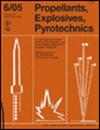含硝酸酯类增塑剂的 GAP 推进剂的热结构损伤和热分解特性分析
IF 1.7
4区 工程技术
Q3 CHEMISTRY, APPLIED
引用次数: 0
摘要
GAP 和硝酸酯化合物分别作为高能粘合剂和高能增塑剂被引入固体推进剂配方中,以进一步提高固体推进剂的能量水平。然而,在异常热条件下,GAP 推进剂中的各种成分,尤其是硝酸酯增塑剂,会因热应力和成分分解缓慢等因素共同导致推进剂内部产生大量空隙。这种现象会影响固体火箭发动机的安全性,因此有必要对其热分解过程和热损伤结构进行研究。本研究采用 DSC-TG 和 FT-IR 技术研究了不同硝酸酯增塑剂配方的 GAP 推进剂的热分解特性和气体产物。通过 Micro-CT 研究了未点火条件下加热 GAP 推进剂的损伤结构,考察了加热条件和硝酸酯增塑剂对 GAP 推进剂热损伤结构的影响。研究发现,在加热过程中,GAP 推进剂的热损伤结构包括 GAP 粘合剂内部产生的空隙以及 GAP 粘合剂与颗粒之间界面的裂缝,而硝酸甘油作为增塑剂会加剧 GAP 推进剂的热损伤(约 2.2-2.9 倍)。本文章由计算机程序翻译,如有差异,请以英文原文为准。
Thermal structural damage and thermal decomposition characterization of GAP propellants with nitrate ester plasticizers
GAP and nitrate ester compounds are introduced into the solid propellant formulation as energetic binders and energetic plasticizing agents, respectively, to further enhance the energy level of solid propellants. However, under abnormal thermal conditions, various components within GAP propellants, especially nitrate ester plasticizers, can collectively result in the generation of a large number of voids within the propellant due to factors such as thermal stress and slow component decomposition. This phenomenon can impact the safety of solid rocket engines, necessitating research into their thermal decomposition processes and thermal damage structures. In this study, the thermal decomposition characteristics and gas products of GAP propellants with different nitrate ester plasticizer formulations were investigated using DSC‐TG and FT‐IR. The damage structure of GAP propellants heated under unignited conditions was studied through Micro‐CT, examining the influence of heating conditions and nitrate ester plasticizers on the thermal damage structure of GAP propellants. During heating, the thermal damage structure of GAP propellants was found to include voids generated within the GAP binder and cracks at the interface between the GAP binder and particles, with nitroglycerin as a plasticizer exacerbating the thermal damage of GAP propellants (about 2.2–2.9 times).
求助全文
通过发布文献求助,成功后即可免费获取论文全文。
去求助
来源期刊

Propellants, Explosives, Pyrotechnics
工程技术-工程:化工
CiteScore
4.20
自引率
16.70%
发文量
235
审稿时长
2.7 months
期刊介绍:
Propellants, Explosives, Pyrotechnics (PEP) is an international, peer-reviewed journal containing Full Papers, Short Communications, critical Reviews, as well as details of forthcoming meetings and book reviews concerned with the research, development and production in relation to propellants, explosives, and pyrotechnics for all applications. Being the official journal of the International Pyrotechnics Society, PEP is a vital medium and the state-of-the-art forum for the exchange of science and technology in energetic materials. PEP is published 12 times a year.
PEP is devoted to advancing the science, technology and engineering elements in the storage and manipulation of chemical energy, specifically in propellants, explosives and pyrotechnics. Articles should provide scientific context, articulate impact, and be generally applicable to the energetic materials and wider scientific community. PEP is not a defense journal and does not feature the weaponization of materials and related systems or include information that would aid in the development or utilization of improvised explosive systems, e.g., synthesis routes to terrorist explosives.
 求助内容:
求助内容: 应助结果提醒方式:
应助结果提醒方式:


